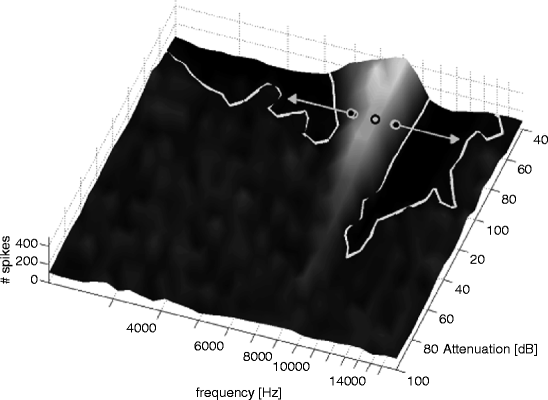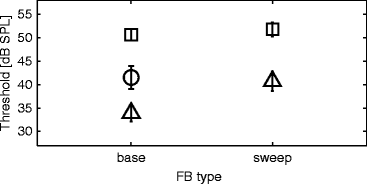Fig. 52.1
Examples of the waveforms (top row) and schematic plots of the spectrograms (bottom row) of the stimuli for the conditions RF (left column), CM (middle column) and CD (right column). The masker is shown in grey and the signal in black. The signal level relative to that of the OFM was 6 dB. The spectrograms for the CM and the CD conditions are shown with sweeping FBs. In addition, the dotted lines indicate the spectrogram of the FBs with fixed centre frequencies (base stimuli). The temporal position of the signal is indicated by the vertical dashed lines and, in the top panels, with a horizontal filled bar
Seven normal-hearing listeners participated. A three-alternative, forced-choice procedure with adaptive signal-level adjustment was used to determine the masked threshold of the signal. The intervals in a trial were separated by gaps of 500 ms. Listeners had to indicate which of the intervals contained the target signal. Visual feedback was provided after each response. The level of the target was adjusted according to a two-down, one-up rule to estimate the 70.7 % point of the psychometric function. The initial step size was 4 dB. After every second reversal the step size was halved until a step size of 1 dB was reached. The run was then continued for another six reversals. The mean level at the last six reversals was used as an estimate of the threshold. The final individual threshold estimate was taken as the mean over four threshold estimates.
2.2 Physiology
Experiments were performed on anaesthetised, pigmented Guinea pigs weighing between 345 and 550 g (for details, see Neuert et al. (2004)). The experiments were performed under the terms and conditions of the project licence issued by the United Kingdom Home Office to the last author (IMW). Single units in the dorsal cochlear nucleus (DCN) were recorded extracellularly with glass-coated tungsten microelectrodes. In contrast to the psychoacoustical experiment, the centre frequency of the OFM was normally set equal to the BF of the unit. The number and spacing of the FBs were identical in the CM and the CD conditions and were chosen according to the response map of the unit. The carriers of the FBs were rising (upper FBs) or falling (lower FBs) sweeps with a sweep rate of one octave per second. If possible, the FBs were placed directly into the inhibitory sidebands of the response area of the unit. The frequency separation between the OFM and the nearest FB was at least twice as large as the spacing between adjacent FBs. An example of the positioning of the OFM and flanking bands is shown in Fig. 52.2.


Fig. 52.2
Response map of a unit showing inhibition (unit 1514007). Since the unit had very low spontaneous activity (<2 spikes/s), the response map was measured in the presence of a low-level excitatory tone burst, positioned at 10 dB above BF threshold. The solid white line demarcates the boundaries of the sideband inhibition of the unit. The black circle filled with grey indicates the position of the OFM. The grey circles filled with black indicate the frequencies of the FBs at the beginning of the stimulus. The arrows indicate the frequency ranges covered by the sweeping FBs
3 Results
Figure 52.3 shows the results of the psychoacoustical experiment for the base stimuli and the sweep stimuli. Thresholds for the CD conditions were highest and were essentially the same for the base and sweep conditions (difference = 1 dB). The threshold for the RF condition was 9 dB lower than for the CD conditions. The lowest threshold of 34 dB was for the CM condition in the base condition. The CMR was 27 dB using the CD condition as a reference. For sweeping FBs the CMR was reduced to 21 dB.


Fig. 52.3




Average thresholds are lower in the CM condition for both base and sweep stimuli. Data from seven normal-hearing listeners. The CD (squares), CM (triangles) and RF (circle) conditions. Error bars indicate ± one standard error
Stay updated, free articles. Join our Telegram channel

Full access? Get Clinical Tree


